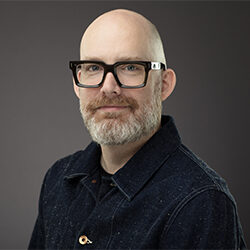- Academics
- Admissions & Enrollment Services
- Research
- Academic & Creative Spaces
- Strategic Partnerships
- Our Impact
- Student Affairs
- Campus & Community
Levi Hammett
Kinetic Imaging
Specialization
Design at the intersection of technology, computation, and craft.
Education
- MFA in Graphic Design, Rhode Island School of Design, 2006.
- BFA in Graphic Design, Oregon State University, 2003.
Biography
Born in a cabin without electricity in the remote mountains of northern California, Levi Hammett developed a deep interest in geographic space together with the concept and process of location. Raised in a blue-collar family he worked as a sign painter and carpenter before pursuing a formal education in design focusing on coding and automation. This background developed into a creative practice that uses computational processes to inform the creation of hybrid design objects incorporating digital technologies that are rooted in traditions of craft.
His work includes a series of hand-made Islamic carpets that explore the urban culture of the Arabian Peninsula, a kinetic installation using 40 printers suspended from the ceiling outputting typography and imagery scraped from the web, and a series of digital displays imagining alternative histories of Arabic typography.
His work has been acquired by several notable individuals and institutions, including the private collection of Her Excellency Sheikha Al Mayassa bint Hamad bin Khalifa Al Thani. His work has been published in print and online collections, distributed as digital applications, and exhibited in Asia, Europe, the Middle East, South America, and the United States.
In 2019 Levi co-founded xLab, a non-hierarchical research and development studio working to produce electronic art, curricula, and tools to extend creative practice.
Levi Hammett received his MFA in Graphic Design from the Rhode Island School of Design in 2006.
levihammett.com
xlab.qatar.vcu.edu
Research Interests
Levi Hammett’s research practice is concerned with creating design objects that enable users to relate to their spatial environment in unexpected yet insightful ways, with the aim of expanding their awareness and understanding of the physical world. The objects span a range of media that includes traditional graphic design, digital interface design, game design, photography, and product design. Despite the variety of media, every object shares a focus on creating playful interfaces and spaces that invite users to interact, either physically or cognitively. These interactions have the potential to reveal new perspectives, comparisons, and insights about a user’s relationship to space, place, and location.
Teaching Experience
- Virginia Commonwealth University in Qatar, Doha, Qatar.
- School for Poetic Computation, New York University, New York, New York, United States.
- CommDe, Chulalongkorn University, Bangkok, Thailand.
- Oregon State University, Corvallis, Oregon, United States.
- Rhode Island School of Design, Providence, Rhode Island, United States.














